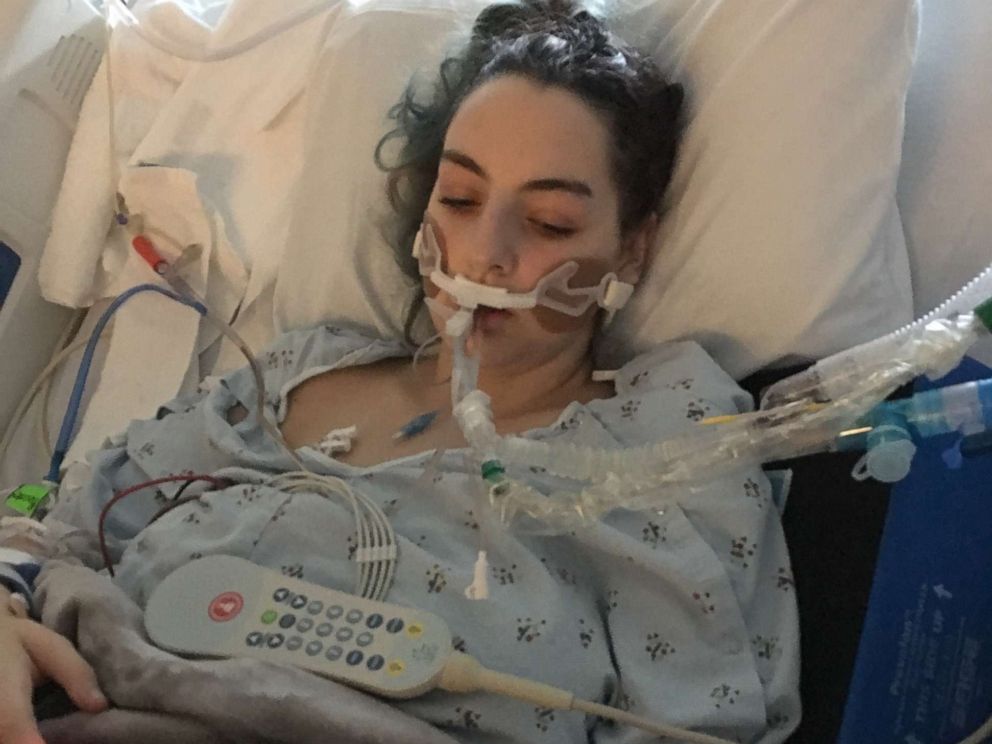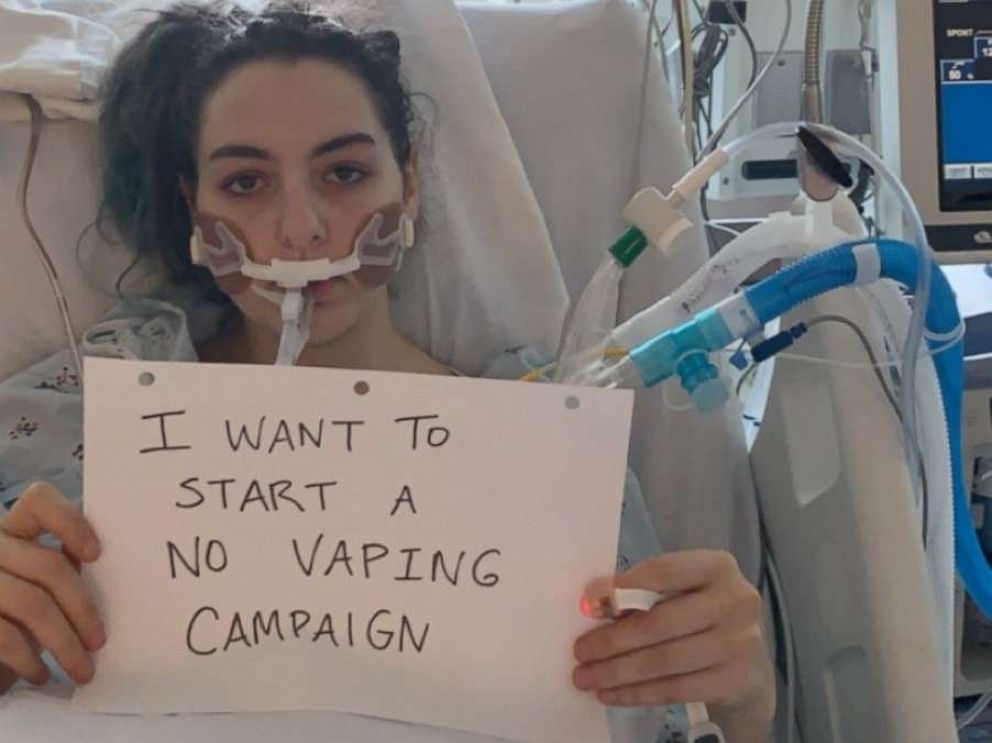
By SALLY HAWKINS, KNEZ WALKER and ANTHONY RIVAS
Sep 11, 2019, 10:37 AM ET Sep 11, 2019, 10:37 AM ET
Though she might not look like it today, Simah Herman said she was sure she was going to die last month as she sat in the car unable to breathe, her father racing her to the hospital. “I just remember feeling like absolute…nothing. Like I just couldn’t do anything,” Herman, 18, said. “I couldn’t drink water. I couldn’t move. Like, I literally just wanted to crawl out of my skin.
The doctors looking after Herman at Los Angeles’ Ronald Reagan UCLA Medical Center were also stumped. On that day, Aug. 15, a chest X-ray showed white hazy areas at the bottom of her lungs, which her pulmonologist, Dr. Kathryn Melamed, said could potentially be pneumonia. Less than 48 hours later, chest X-rays showed that her lungs were filled with white — they were inflamed and full of fluid, Melamed said.
“My best guess since we’re still learning about what is really going on in the lungs is [it’s a] profound inflammatory reaction to the vape products or some…component of the vape products,” Melamed said.
Still unable to breathe after two days, Herman had to be put on a ventilator, and shortly afterward, a medically induced coma. It was while she was in the coma that her cousin revealed a secret that Simah had been keeping from her parents that helped lead to some answers. “She said, ‘You know she smokes every day?’” said Stacy Herman, Simah Herman’s mother. “I said, ‘What? What are you talking about?’ And she said, ‘She smokes every day. She smokes that vape.’ I said, ‘You tell the doctors right now. You go tell the doctors right now.’” By the time that Simah Herman had emerged from her coma, she had been in the hospital for five days. With a ventilator still pumping oxygen into her failing lungs, the teen who said she would vape every 10 to 15 minutes decided to become an advocate against vaping.

“I asked for, like, a pen and paper because that was the only way I could communicate,” Simah Herman said. “And I wrote, ‘I want to start a no-vaping campaign.’ That was the first thing I did when I opened my eyes.”

Simah Herman’s story is one of the latest in a string of cases of serious — sometimes even life-threatening — illnesses linked to vaping.
As of Sept. 10, there have been six confirmed deaths and over 450 possible cases of lung illness in 33 states associated with e-cigarette products, according to the Centers for Disease Control and Prevention (CDC), which noted that in addition to nicotine, patients also reported using e-cigarette products with liquids containing cannabinoids like THC, the active compound in marijuana. Many of the cases involve teens. Just last month, 17-year-old Trystan Zohfeld spent 18 days in the hospital after suffering from a vaping-related illness, during which he said he was “throwing up everywhere.” On Monday night, a Texas high schooler was also rushed to the hospital after vaping.
Melomed is one of countless health officials who fear that vaping-related illnesses are an emerging crisis. Among high school students, there was a 78% increase in e-cigarette use between 2017 and 2018, according to the Food and Drug Administration’s (FDA) National Youth Tobacco Survey.
Simah Herman said she first started vaping at age 15, and that she’d buy the cartridges from a smoke shop despite being a minor. “I went in and I was like, ‘Can I get a pack of Juul pods?’ And they were like, ‘How old are you?’ And I said, ‘22,’ and they were just like, ‘OK,’” Simah Herman said.
Just this week, the FDA sent a warning letter to Juul, the industry leader for vape products, accusing it of illegally marketing its nicotine vape products as safer than traditional cigarettes without proof.In a statement to ABC News, Juul said it was reviewing the FDA letter and that it would “fully cooperate.”
“We share these concerns about youth vaping, which is why we have taken the most aggressive actions of anyone in the industry to combat youth usage,” Juul said. “We strongly advocate for Tobacco 21 legislation, we stopped the sale of non-tobacco and non-menthol-based flavored JUULpods to our traditional retail store partners, enhanced our online age-verification process, strengthened our retailer compliance program with over 2,000 secret shopper visits per month and shut down our Facebook and Instagram accounts while working constantly to remove inappropriate social media content generated by others on those platforms.
“Most recently, we announced the deployment of technology at retail stores that automatically restricts the sale of JUUL products until a government-issued ID is electronically scanned to verify age and ID validity,” the company continued. “This technology also limits the amount of JUUL products that can be purchased to prevent reselling or sharing to those underage, and it will soon be mandatory for all JUUL product sales across the country.”
Simah Herman was healthy and active when she first started vaping. She had been a dancer for years, even making the dance team during her freshman year of college. But she said her abilities started to diminish as her vaping habit increased and she began vaping cannabis as well. Eventually, she was vaping a nicotine cartridge a day, with the total amount of nicotine in one cartridge the same as that in a pack of cigarettes. “I didn’t think of myself as a smoker. Like, it’s just a different kind of smoke,” Simah Herman said. “The vaping just makes it seem like nothing. Like you’re doing nothing wrong.”
In the two years that she had been vaping, Simah Herman said she lost 50 pounds “without trying” because she felt sick all the time. She said she often felt nauseous and dizzy, too, and that she didn’t notice how her appearance had changed.
As her health issues worsened, she also stopped going to classes. Doctors, meanwhile, weren’t able to offer any solid answers, even though she would tell them that she vaped, she said. “I told every doctor that I went to just because I had such severe issues,” she said. “I wanted to make sure that…wasn’t making anything worse, but no doctor ever said, like, ‘Maybe you should stop vaping.’”
Melamed said there is a lot that’s still unknown about the consequences of vaping. “We don’t know which components — if it’s a certain component or certain product [or] certain brand that is responsible for both the short- and long-term effects of vaping,” she said.
Stacy Herman, however, believes the whole industry — not just Juul — markets to minors purposely. After she discovered that her daughter was hiding her vape addiction, she said she “ransacked her room” and “found all the vapes.”
“The fact that they market this crap to children, and they turn it into pink, pretty purple packaging [kind of] pisses me off,” Stacy Herman said. “I’m so angry that [Simah] can get a hold of this thinking it’s nothing wrong with it because everyone’s doing it. … It looks and smells like mango, and it looks and smells like bubblegum and her room smells delicious. I smell[ed] the packages. They smell great.”
Although Simah Herman has stopped vaping, she said she still feels compelled to pick one up. “Now I don’t necessarily crave the nicotine. I don’t necessarily crave the weed. It’s just craving, like, the act of smoking,” she said. “So that’s been the hardest thing…staying away from it.”
Hoping that her story going public will help to discourage e-cigarette use, she said that she’d tell teens who want to try vaping that she once wanted to try it just once, too.
But then “I tried it another time and then another time. It’s just remembering that you don’t need it. Like, it’s going to kill you.”
Source: ABC News